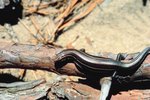
Spitting cobras can spit potentially blinding venom at their adversaries in self defense. They're found throughout Africa and South Asia, and though they show great diversity in terms of lifestyle, habitat and diet, most reproduce in similar fashion. Solitary animals, males and females come together briefly to mate; females deposit eggs a few months later, and the hatchlings emerge 8 to 12 weeks after being deposited.
Combat
Males of some cobra species will engage in ritualized combat when searching for mates. When two males encounter each other, they will rear up the anterior portion of their bodies and intertwine them in a type of wrestling match. The object of the fight is to pin the opposing male’s head to the ground. Bites during such encounters are rare, and generally the loser of the match will crawl away unharmed while the male prowls the territory for receptive females.
Mating
Spitting cobras reproduce sexually; males will use one of their two hemipenes to transfer sperm to the female. Hemipenes are usually inverted and carried inside the male’s body. When it's time for mating, one hemipenis is everted through the male’s vent and inserted in the vent of the female. Mating can be as brief as a few minutes or can last hours in some cases. Mating is a seasonal event in most species, but those species found near the equator may reproduce at any time of the year.
Egg Deposition
Spitting cobras deposit their eggs in secluded locations like termite mounds, rotten logs, animal burrows and under rocks. The number and size of the eggs varies with both the species and individual. Large Mozambique spitting cobras (Naja mossambica) may deposit 25 or more large eggs, while a small black-necked spitting cobra (Naja nigricollis nigricollis) may only lay 10, relatively small, eggs.
Ovoviviparity
One species, the rinkhals (Hemachatus haemachatus), is only distantly related to the typical spitting cobras (Naja sp.) and reproduces in a different manner. Rinkhals engage in ovoviviparity -- a reproductive method similar to live birth as seen in mammals. Rinkhal babies are encased in a flexible, unshelled egg while inside their mother. Shortly before, during or after the time of parturition, the soft eggs rupture and the live snake pops out. Rinkals are prolific spitting cobras, sometimes producing more than 60 babies -- though, as with many ovoviviparous snakes, they may only produce babies every second or third year.
Neonates
Spitting cobras are able to spit or inject venom as soon as they hatch. The venom of young cobras is just as toxic as that of adults, but due to their small size, they don’t inject as much as the adults do. Spitting cobras do not practice parental care, and the young must fend for themselves immediately.
References
- TigerHomes.org: Spitting Cobra
- San Diego Zoo: Cobra
- Devenomized.com: Captive Care of the Rinkhals Spitting Cobra Hemachatus Haemachatus
- Devenomized.com: Captive Care of the Mozambique Spitting Cobra Naja Mossambica
- Devenomized.com: Captive Care of the Black-neck Spitting Cobra Naja Nigricollis Nigricollis
Photo Credits
-
Digital Vision/Digital Vision/Getty Images




